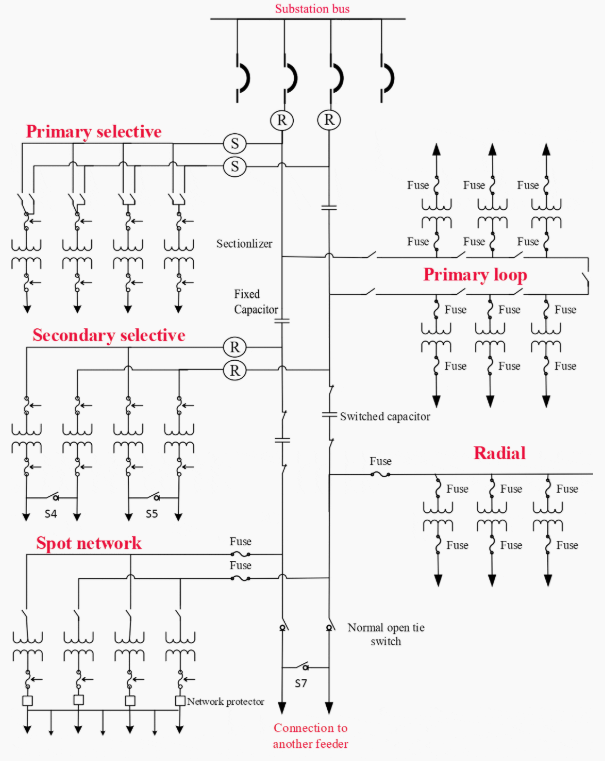Main keywords for this article are Electrical Power Distribution System Design, Electrical Load Classification, Power System Grounding Requirements, Automatic Transfer Switch, Energy Metering.
Electrical Power Distribution System Design in Plants
The basic intention in the development of the power distribution system shall be to develop a safe, flexible system, that will provide continuity of service in the event of a partial power outage or when equipment is taken out of service for maintenance. The design shall provide for convenient operation, ease of maintenance, future expansion and component interchangeability. The system shall be designed, and the protective relaying shall be coordinated, to provide minimum system disruption when isolating an electrical fault.
System shall be designed such that the necessary elements such as switchgear, cables, etc. are currently manufactured, and type tested. Equipment with a minimum of three years field proven experience shall be selected.
Electrical Bus and System Configurations
When selecting the distribution system configuration, factors of reliability, application and investment cost shall be considered. The three basic system arrangements to consider are:
Radial System
a. This system is the simplest and easiest to understand, operate and diagnose. It is also the least expensive.
b. Radial systems are made up of single feeders, buses, transformers and power sources.
c. This type of system does not provide an alternate source of power, or redundant components, so any major system component failures will result in loss of power and facility shutdown.
Primary-Selective System
a. This system offers a higher level of reliability and flexibility than the simple radial system.
b. Primary-selective systems have redundant feeders fed from two separate power sources, so only half of the system transformers are on a single feeder. In the event of feeder failure, the affected load can be switched over to the alternate feeder for continued operation.
c. Since this system requires additional feeders, feeder protection and switching, the investment cost is higher than the radial system.
Secondary-Selective System
a. This system offers the highest level of reliability and flexibility of the three basic types.
b. Secondary-selective, also known as, double-ended systems are made up of double feeders fed from two separate power sources, double transformers and double buses. The buses are connected together by a circuit breaker, known as the tie breaker, that is normally left open.
c. In the event of a component failure or fault, power to half of the load would be lost, with the auto transfer scheme the system can be reestablished by closing the tie breaker.
d. Due to the amount of duplication of major components in this type of system it also requires the greatest investment cost of the three types of system.
e. Where it has been determined that a loss of power could lead to a situation that is hazardous to human life, or where substantial loss of production could result, secondary-selective systems shall be used.
Electrical Load Classification
- Normal Loads:
Loads where a single contingency failure could not lead to a situation that is hazardous to human life or cause a substantial loss of production. Normal loads can tolerate prolonged power failure without causing plant shut down e.g. Secondary office buildings, Warehouses and Workshops. Radial or Primary-Selective System shall be considered to supply such loads. - Critical Loads:
Loads where a single contingency failure could lead to a situation that is hazardous to human life or cause a substantial loss of production and plant major shut down e.g. Major office buildings, Major computer or IT centers and Process units. Secondary-Selective System shall be used to supply such loads. - Emergency Loads:
These loads are those whose operation involves the safeguard of an item of equipment/installation or the continuation of certain operations. In case of shutdown, emergency loads tolerate a short interruption of service, but it shall be automatically restarted and re-fed by emergency generator e.g. loads defined at Power System and Equipment Design Calculations. These loads shall be supplied from an emergency switchgear fed from a secondary-selective system and emergency generator. - Vital Loads:
Loads whose operation affects personnel safety whether directly or indirectly. These loads do not allow the power supply interruption and shall be fed by UPS system e.g. DCS, Fire Alarm, Gas detection and Substation control systems.
Liquid Immersed Air Cooled Power, and Dry Type Transformers
- In the power distribution system, liquid immersed air cooled power transformers shall be in accordance with Oil-Immersed Power Transformers Design Requirements.
- Oil immersed power transformers rated below 2.5 MVA shall be “hermetically sealed” tank type equipped with off-load tap changer.
- All LV/LV transformers shall be dry type unless otherwise specified.
- Dry type transformers shall be rated in accordance with Dry Type Distribution and Power Transformers Design Notes.
- For voltage tap and fan rating requirements see the data sheet specific to the transformer.
- The transformer shall be derated to compensate for the extreme environment it is to be installed in, to provide continuous operation without a sacrifice in service life.
Power System Grounding Requirements
- Three phase electrical systems shall be grounded at the neutral point of wye connected windings for transformers and generators.
- High resistance grounding systems may be approved by company if it is proved that the following shall be provided:
a. Full time operations or maintenance personnel familiar with ground fault location procedures and equipment.
b. Ground fault location equipment, provided as part of the high resistance grounding system.
c. A ground fault alarm system.
d. A protective relaying system capable of isolating a second ground fault.
Automatic Transfer Switch
- In situations where power is critical to life safety or continuous process operations a system shall be provided to automatically switch to an alternate or emergency source of power in the event of loss of the normal source. These automatic transfer switches and their related control systems shall be capable of sensing critical undervoltage and instantaneously transferring the critical load to the alternate source.
- If the alternate source is a generator, the control system shall be equipped with provisions for generator starting.
- The automatic transfer switch shall be of transferred back to the normal power supply manually, when normal system conditions have been restored.
- The automatic transfer switch shall be a double throw type switch with no off or neutral positions provided. The most commonly used configurations shall be double throw, mechanically held, electrically operated or static transfer type.
Extra High and High Voltage Switchgear
- High voltage switchgear, where required, shall be utilized for controlling and distributing power at voltages of 100 kV and above. It shall be of the metalenclosed SF6 gas insulated type.
- 115 kV and 230 kV Gas insulated switchgear shall be in accordance with NEC High Voltage Gas Insulated Switchgear Design Requirement.
- The switchgear shall be installed indoors. The arrangement shall be three phase or single phase enclosed, consisting of completely pressurized separate sections provided with rupture protection.
- Busbar shall also be three phase or single phase enclosed.
- The circuit breakers shall be of the SF6 gas, single pressure puffer type, with a highly reliable hydraulic or pneumatic operating mechanism.
Medium Voltage Switchgear
- Medium voltage switchgear shall be utilized in air-conditioned substations for controlling and distributing power at voltages above 1 kV to less than 100 kV.
- Medium voltage switchgear shall be in accordance with NEC Medium Voltage Switchgear Design Requirement . It shall be arranged in a single row, a back to back arrangement is unacceptable. The switchgear shall be designed to allow the installation of additional sections at a future date.
- Each section shall be equipped with removable draw out vacuum or SF6 type switchgear assemblies that are identical in type and physical dimensions, for the purpose of interchangeability.
Low Voltage Switchgear
Low voltage switchgear shall be in accordance with NEC Low Voltage Switchgear Design Requirement. Low voltage switchgear shall be utilized for controlling or distributing power at voltages of 1000 V or less. Generally this equipment shall be installed indoors. The switchgear shall be of the metal enclosed, freestanding, dead front steel structure type.
Station Batteries and Battery Charger
- Station Batteries and Battery charger shall be in accordance with Batteries, Racks and Battery Chargers in Plant.
- The highly reliable 125 V dc redundant control power required for switchgear shall be provided by stationary storage batteries.
- Station batteries shall be lead calcium plates or nickel-cadmium type having a service life of not less than 20 years.
- The batteries shall be located indoors, in racks, near the load to be served. The system shall be capable of delivering full rated output for the period of time stated in the data sheet.
- The batteries shall be connected to a battery charger and to a load bus.
- The battery charger shall be capable of supplying the required load current and the battery charging current.
- The charger shall be the electronically controlled type, fully regulated and current limiting.
- Circuit breaker protection shall be provided for both input and output. The dc output shall be isolated.
Energy Metering
Individual tariff precision metering of following sections are required for both active (kWh) and reactive (kVARh) energies and shall also be available at SCADA and DCS.
Plant total
S/Ss total (all substations)
Each process section
Utility
Off Site
EDG
All main incomer feeders (normal and emergency) upto 480 Volt LV switchgear.
Electrical Reliability-
All motors and critical equipment /systems for the process shall have a minimum voltage dip protection.
Main and spare pump motors must be connected to different buses.
Half of the fan motors of any air-cooled exchangers must be connected to the „A‟ bus and the other half to the „B‟ bus.

